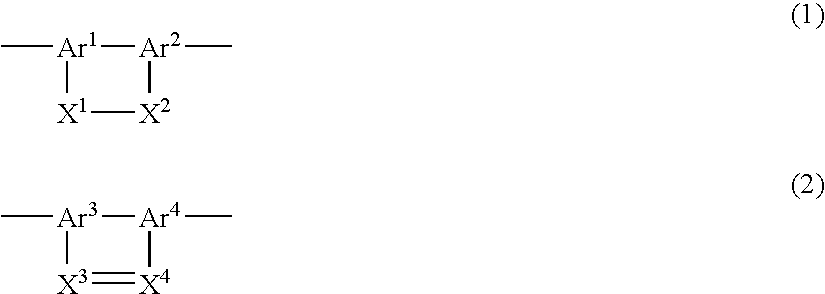Polymer Compound And Polymer Light-Emitting Device Using The Same
a technology of polymer compound and light-emitting device, which is applied in the direction of conductive layers on insulating supports, natural mineral layered products, synthetic resin layered products, etc., can solve the problem of unsatisfactory light-emitting strength, and achieve the effect of strong light-emitting strength
- Summary
- Abstract
- Description
- Claims
- Application Information
AI Technical Summary
Benefits of technology
Problems solved by technology
Method used
Image
Examples
example 1
Synthesis of Compound 1
[0300]6.65 g (19.9 mmol) of 2,7-dibromo-9-fluorenone was put in a 500 ml three-necked flask having replaced the inside by nitrogen, and dissolved in 140 ml of a mixed solvent of trifluoro acetic acid:chloroform=1:1. To this solution, sodium perborate 1 hydrate was added, and stirred for 20 hours. The reaction liquid was filtration through celite, and washed with toluene. The filtrated liquid was washed with water, sodium hydrogensulfite, and saturated NaCl aqueous solution, and then it was dried by sodium sulfate. After the solvent was distilled off, 6.11 g crude product was obtained.
[0301]This crude product was recrystallized from toluene (33 ml), and 4.99 g of Compound 1 was obtained. Furthermore, it was recrystallized from chloroform (50 ml), and 1.19 g of Compound 1 was obtained.
[0302]1H-NMR (CDCl3, 300 MHz): 8.52 (s, 1H), 7.97-7.86 (m, 3H), 7.55-7.46 (m, 2H)
[0303]GC-MS (m / z): 356, 354, 352
example 2
Synthesis of Compound 2
Preparation of C8H17MgBr
[0304]Magnesium 1.33 g (54.2 mmol) was put in a 100 ml three necked flask, and flame-dried, and replaced the inside with argon. THF 10 ml and 1-bromooctane 2.3 ml (13.6 mmol) were added and heated to start the reaction. After refluxing for 2.5 hours, it was left cooling to a room temperature. Grignard reaction
[0305]1.00 g (p. 96%, 2.7 mmol) of 1 was put in a 300 ml three-necked flask having replaced the inside by nitrogen, and suspended in 10 ml THF. After cooling to 0° C., C8H17MgBr solution prepared above was added. The cooling bath was removed and it was stirred under reflux for 5 hours. After standing the reaction liquid to cool, 10 ml of water and hydrogen chloride were added. Although it was suspension liquid before adding hydrogen chloride, it became a solution of two phases after the addition. After partition, the organic phase was washed by water and saturated NaCl aqueous solution. It was dried with sodium sulfate and the solv...
example 3
Synthesis of Compound 3
[0308]0.20 g (0.32 mmol) of 2 was put in a 25 ml two-necked flask having replaced the inside by nitrogen, and dissolved in 4 ml of toluene. To this solution, 0.02 g (0.06 mmol) of p-toluene sulfonic acid 1 hydrate was added, and stirred at 100° C. for 11 hours. After standing the reaction liquid to cool, the reaction liquid was washed with water, 4N NaOH aqueous solution, and saturated NaCl aqueous solution in the order of water, and the solvent was distilled off. 0.14 g of Compound 3 was obtained.
[0309]1H-NMR (CDCl3, 300 MHz): 7.59 (d, 1H), 7.53 (d, 1H), 7.47 (d, 1H), 7.29 (br, 1H), 7.15 (s, 1H), 7.13 (d, 1H), 1.92 (br, 4H), 1.28 (m, 24H), 0.93 (t, 6H)
[0310]FD-MS (m / z): 566, 564, 562
PUM
| Property | Measurement | Unit |
|---|---|---|
| liquid-crystal property | aaaaa | aaaaa |
| fluorescence | aaaaa | aaaaa |
| conductive | aaaaa | aaaaa |
Abstract
Description
Claims
Application Information
 Login to View More
Login to View More - R&D
- Intellectual Property
- Life Sciences
- Materials
- Tech Scout
- Unparalleled Data Quality
- Higher Quality Content
- 60% Fewer Hallucinations
Browse by: Latest US Patents, China's latest patents, Technical Efficacy Thesaurus, Application Domain, Technology Topic, Popular Technical Reports.
© 2025 PatSnap. All rights reserved.Legal|Privacy policy|Modern Slavery Act Transparency Statement|Sitemap|About US| Contact US: help@patsnap.com



